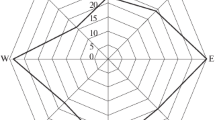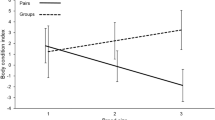Summary
Nuthatches (Sitta europaea) usually forage in pairs outside the breeding season. I investigated whether foraging site selection in winter (tree species, height, substrate size) differed between sexes and whether this difference was related to the presence of mixed-species flocks. Foraging sites of pair members foraging together were highly correlated. In the rare cases when each used different tree species, males foraged significantly more often on the preferred oak trees than females. Males foraged significantly lower than females in some territories, but not in others. The reasons for this significant variation between pairs remains unexplained. Males also foraged lower than females in the company of mixed flocks. These differences are probably better explained as avoidance of the dominant male by the subordinate female, rather than specialization in resource use to avoid competition.
Zusammenfassung
Außerhalb der Brutzeit fouragieren Kleiber gewöhnlich in Paaren. Ich untersuchte, ob sich die Geschlechter in der Wahl des winterlichen Nahrungsortes (Baumart, Höhe, Astdicke) unterscheiden und ob solche Unterschiede durch die Anwesenheit von gemischten Schwärmen beeinflußt ist. Die Ortswahl der gemeinschaftlich auf Nahrungssuche gehenden Paarpartner war hoch korreliert. In den seltenen Fällen, in denen sich die Partner an verschiedenen Bäumen aufhielten, fanden sich die Männchen signifikant mehr an den der Art bevorzugten Eichen als die Weibchen. In einigen Revieren fouragierten die Männchen an signifikant niedrigeren Standorten als die Weibchen, doch war dies nicht in allen Revieren der Fall. Die Ursachen für diese Unterschiede sind nicht bekannt. Auch in gemischten Schwärmen erfolgte die Nahrungssuche der Männchen niedriger als die der Weibchen. Möglicherweise vermeiden die Weibchen so die Konkurrenz durch die dominanten Männchen.
Similar content being viewed by others
References
Alatalo, R. V., Eriksson, D., Gustafsson, L. & Larsson, K. (1987). Exploitation competition influences the use of foraging sites by tits: experimental evidence. Ecology 68: 284–290.
Aulén, G. & Lundberg, A. (1991). Sexual dimorphism and patterns of territory use by the White-Backed WoodpeckerDendrocopos leucotos. Ornis Scand. 22: 60–64.
Barnard, C. J. & Thompson, D. B. A. (1985). Gulls and Plovers, the ecology and behaviour of mixed-species feeding groups. London.
Bilcke, G., Mertens, R., Jeurissen, M. & Dhondt, A. A. (1986). Influences of habitat structure and temperature on the foraging niches of the pariform guild in Belgium during winter. Giervalk 76: 109–129.
Carpenter, F. L., Hixon, M. A., Russell, R. W., Paton, D. C. & Temeles, E. J. (1993). Interference asymmetries among age-sex classes of rufous hummingbirds during migratory stopovers. Behav. Ecol. Sociobiol. 33: 297–304.
Desrochers, A. (1989). Sex, dominance and microhabitat use in wintering Black-capped Chickadees: a field experiment. Ecology 70: 636–645.
Ebenman, B. (1986). Sexual size dimorphism in the great titParus major in relation to the number of coexisting congeners. Oikos 47: 355–359.
Ekman, J. & Askenmo, C. (1984). Social rank and habitat use in Willow Tit groups. Anim. Behav. 32: 508–514.
Ekman, J. & Hake, M. (1988). Avian flocking reduces starvation risk: an experimental demonstration. Behav. Ecol. Sociobiol. 22: 91–94.
Enoksson, B. (1988). Age and sex differences in dominance and foraging behaviour of Nuthatches (Sitta europaea). Anim. Behav. 36: 231–238.
Giraldeau, L.-A. (1984). The skill pool effect and frequency-dependent learning. Am. Nat. 124: 72–79.
Gosler, A. G. (1987). Pattern and process in the bill morphology of the Great TitParus major. Ibis 129: 451–476.
Grubb, T. C. (1982). On sex-specific foraging behavior in the White-breasted Nuthatch. J. Field. Ornithol. 53: 305–314.
Gustafsson, L. (1988). Foraging behaviour of individual coal tits,Parus ater, in relation to their age, sex and morphology. Anim. Behav. 36: 696–704.
Herrera, C. M. (1978). Individual dietary differences associated with morphological variation in Robins (Erithacus rubecula). Ibis 120: 542–545.
Herrera, C. M. (1979). Ecological aspects of heterospecific flocks formation in a mediterranean passerine bird community. Oikos 33: 85–96.
Holmes, R. T. (1986). Foraging patterns of forest birds: male — female differences. Wilson Bull. 98: 196–213.
Kennedy, C. & Southwood, T. R. E. (1984). The number of species of insects associated with British trees: re-analysis. J. Anim. Ecol. 53: 455–478.
Lens, L. (1996). Wind stress affects foraging site competition between crested tits and willow tits. J. Avian Biol. 27: 41–46.
Littell, R. C., Milliken, G. A., Stroup, W. W. & Wolfinger, R. D. (1996). SAS system for mixed models. Cary, NC.
Löhrl, H. (1958). Das Verhalten des Kleibers (Sitta europaea caesia Wolf). Z. Tierpsychol. 15: 191–252.
Matthysen, E. (1986). Some observations on sexspecific territoriality in the Nuthatch. Ardea 74: 177–183.
Matthysen, E. (1988). Populatiedynamiek, sociale organisatie en habitatkwaliteit bij de BoomkleverSitta europaea L. Unpublished Ph.D. thesis, University of Antwerp.
Matthysen, E. (1990a). Nonbreeding social organization inParus. Curr. Ornithol. 7: 209–249.
Matthysen, E. (1990b). Behavioral and ecological correlates of territory quality in the Eurasian Nuthatch (Sitta europaea). Auk 107: 86–95.
Matthysen, E. (1993). Nonbreeding social organization in migratory and resident birds. Curr. Ornithol. 11: 93–141.
Matthysen, E. (1998). The Nuthatches. London.
Matthysen, E., Cimprich, D. & Grubb, T. C. (1991). Social control of sex-specific foraging behaviour in downy woodpeckersPicoides pubescens. Anim. Behav. 42: 515–17.
McEllin, S. M. (1979). Population demographies, spacing, and foraging behaviours of White-breasted and Pygmy Nuthatches in Ponderosa Pine habitat. In: Dickson, J. G., Connor, R. N., Fleet, R. R., Jackson, J. A. & Kroll, J. C. (Eds.): The role of insectivorous birds in forest ecosystems: 301–330. New York.
Morrison, M. L. (1984). Influence of sample size and sampling design on analysis of avian foraging behavior. Condor 86: 146–150.
Morse, D. H. (1967). Foraging relationships of Brown-headed Nuthatches and Pine Warblers. Ecology 48: 94–103.
Morse, D. H. (1977). Feeding behavior and predator avoidance in heterospecific groups. Bioscience 27: 332–339.
Moysey, E. D. (1997). A study of resource partitioning within the Helmeted HoneyeaterLichenostomus melanops cassidix during the non-breeding season. Emu 97: 207–219.
Nicolai, V. (1986). The bark of trees: thermal properties, microclimate and fauna. Oecologia 69: 148–160.
Norris, R. A. (1958). Comparative biosystematics and life history of the nuthatchesSitta pygmaea andSitta pusilla. Univ. Calif. Publ. Zool. 56: 119–300.
Peters, W. D. & Grubb, T. C. Jr. (1983). An experimental analysis of sex-specific foraging in the Downy Woodpecker,Picoides pubescens. Ecology 64: 1437–1443.
Pulliam, H. R. & Caraco, T. (1984). Living in groups: is there an optimal group size? In: Krebs, J. R. & Davies, N. B. (Eds.): Behavioural Ecology: 122–147. Oxford.
Pulliam, H. R. & Millikan, G. C. (1982). Social organization in the nonreproductive season. In: Farner, D. S. & King, J. R. (Eds.): Avian Biology, Vol. 4: 169–197. New York.
Selander, R. K. (1966). Sexual dimorphism and differential niche utilization in birds. Condor 68: 113–151.
Suhonen, J. (1993). Risk of predation and foraging sites of individuals in mixed-species tit flocks. Anim. Behav. 45: 1193–98.
Suhonen, J. & Kuitunen, M. (1991). Intersexual foraging niche differentiation within the breeding pair in the Common TreecreeperCerthia familiaris. Ornis Scand. 22: 313–318.
Sutherland, W. J. (1996). From Individual Behaviour to Population Ecology. Oxford.
Swenson, J. E. (1993). Hazel Grouse (Bonasa bonasia) pairs during the nonbreeding season — mutual benefits of a cooperative alliance. Behav. Ecol. 4: 14–21.
Van Buskirk, J. & Smith, D. C. (1989). Individual variation in winter foraging of black-capped chikkadees. Behav. Ecol. Sociobiol. 24: 257–263.
Waite, T. A. (1987a). Vigilance in the White-breasted Nuthatches: effects of dominance and sociality. Auk 104: 429–434.
Waite, T. A. (1987b). Dominance-specific vigilance in the Tufted Titmouse: effects of social context. Condor 89: 932–935.
Waite, T. A. & Grubb, T. C. Jr. (1988). Copying of foraging locations in mixed-species flocks of temperate-deciduous woodland birds: an experimental study. Condor 90: 132–140.
Wallace, R. A. (1974). Ecological and social implications of sexual dimorphism in five melanerpine Woodpeckers. Condor 76: 238–248.
Woodrey, M. S. (1991). Caching behavior in freeranging White-Breasted Nuthatches — the effects of social dominance. Ornis Scand. 22: 160–166.
Author information
Authors and Affiliations
Rights and permissions
About this article
Cite this article
Matthysen, E. Foraging behaviour of Nuthatches(Sitta europaea) in relation to the presence of mates and mixed flocks. J Ornithol 140, 443–451 (1999). https://doi.org/10.1007/BF01650988
Accepted:
Published:
Issue Date:
DOI: https://doi.org/10.1007/BF01650988




